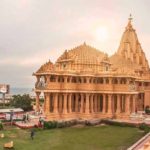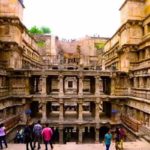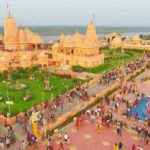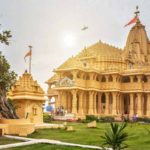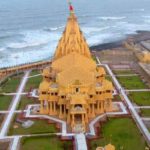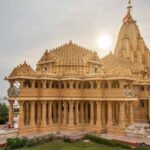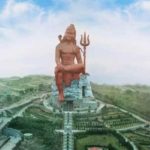Somnath Temple in Gujarat, literally meaning ‘lord of the moon’s is a pilgrimage centre and is home to one of the twelve Jyotirlingas. It is a town which derives much of its identity from the mythology, religion and legends that surround it primely a temple town, Somnath is a place where a strong scent of religion and legends lingers around tourism and even daily life. It’s spiritual environment is surrounded by the huge number of temple in the area, however Somnath also offers beach, museums and other attractions. While the Somnath temple and Somnath beach are primary place to visit here, Gina Mandir,Balukh Tirtha, Kamnath Mahadev Temple, Somnath museum are some of the other place that one can visit.
The Somnath Temple located is Prabhas Patan near Veraval in Saurashtra on the western cost of Gujarat. It is on important pilgrimage and tourist sport of Gujrat. Reconstructed several times in the past after repeated destruction by several Muslim invaders and Portuguese the present temple was reconstruction in Chalukhya style of Hindu temple architecture and completed in May 1951. The reconstruction was completed by Vallabhbhai Patel. The site of Somnath has been a pilgrimage site from ancient times on account of being a triveni sangam, three rivers –Kapil away, Hiran and Sarasvati.
The name of the town Prabhas, meaning lustre, as well as the alternative names Someshvar and Somnath “The lord of the moon” or “the moon God “arise from this tradition. The temple is considered sacred due to the various legend connect to it. Somnath mean “lord of the Soma“ Somnath Temple in Gujarat.
The Somnath Temple is known as “Shrine Eternal “. Somnath is 12 Jyotirlingas in India, where Shiva is believed to have appeared as a flery column of light. The Jyotirlingas are taken as the supreme, undivided reality out of which Shiva partly appears. At all these site the primary image is a lingam representing the beginningless and endless stambha, symbolizing the infinite nature of Shiva. The present temple is built in the chaulukya style of temple architecture or “Kailash Mahameru Prasad “style and reflects the skill of the Sompura Salat’s one of Gujarat’s master masons Gujarat Tour Packages.
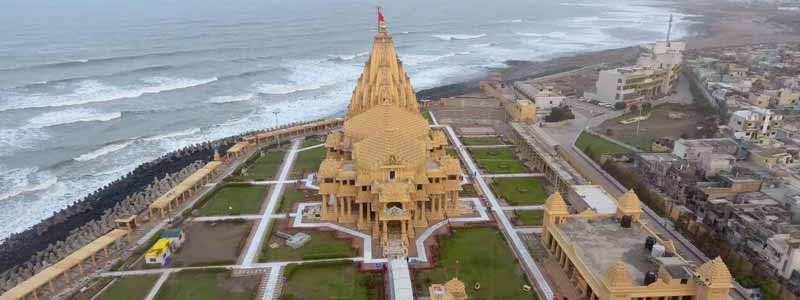
History of Somnath Temple
Since ancient times, the Somnath temple has been treated as one of the greatest pilgrimage sites in India. The major reason for this is the fact that it is located on the confluence of three rivers – also known as Triveni Sangam – namely Kapila, Hiran, and Sarasvati, Somnath Temple in Gujarat.
Many legends are associated with this place. According to one such folklore, once upon a time, Soma, the Moon God, had lost his luster. To regain it, he decided to bathe in the holy waters of river Sarasvati. And it is owing to this that people started believing in the phenomenon of waxing and waning of the moon Gujarat Tourism.
According to the documented works of J. Gordon Melton, it was this place that witnessed the first temple dedicated to Lord Shiva in Somnath. And the second temple is believed to have been built on the same site by the Yadava Kings in around 640 BCE. However, it was in the year 725 BCE that the Arab Governor Al- Junayd is said to have destroyed this temple when he invaded the states of Gujarat and Rajasthan.
Then, in 1024, the cruel Turkic ruler Mahmud of Ghazni did many raids in Gujarat breaking the temple and severely damaging the Jyotirlinga from various places. It is said that he took away with himself a booty worth 20 million dinars.
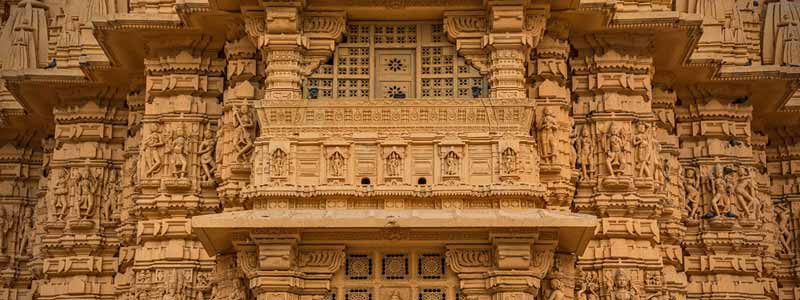
Architecture of Somnath Jyotirlinga Temple
Reconstructed in the Chalukya style of architecture, it showcases the fine skills of the oldest and best temple architects or the Sompura Salats. An arrow pillar mentions that it is located at such a location that it is the first point of land in the north to the South Pole at that particular longitude. The recesses of a balconied corridor also house a rather mutilated form of Nataraja, or the dancing Shiva. The flag atop the temple tower bear the symbols of Nandi and Trishul. Jain influence on the carvings and the overall design is clearly visible despite it being a Brahmanical temple, Somnath Temple in Gujarat.
Major Attractions Around Somnath Temple
- Somnath Beach
Somnath Beach is quite an amazing place to relax and unwind yourself. It is worth noting that the waters around this place are not exactly recommended for swimming because of high and violent waves.
- Paanch Pandav Gufa
Discovered by a saint named Baba Narayandas, this place has been dedicated to the five Pandava brothers. What is really interesting to know is that one can easily get a view of the entire city from this place.
- Laxminarayan Temple
The major highlight of this temple is that it is famous for the 18 pillars on which inscriptions from Bhagwad Gita have been carved out.
- Chorwad Beach
It won’t be wrong to say that Chorwad Beach is actually one of the most culturally thriving places to experience in Gujarat. However, the waters of this place too are not quite ideal for swimming around.
- Suraj Mandir
Located near the Triveni Ghats, this is actually one of the only Sun temples located here. Anyone who is spiritually inclined will like the aura of this place.
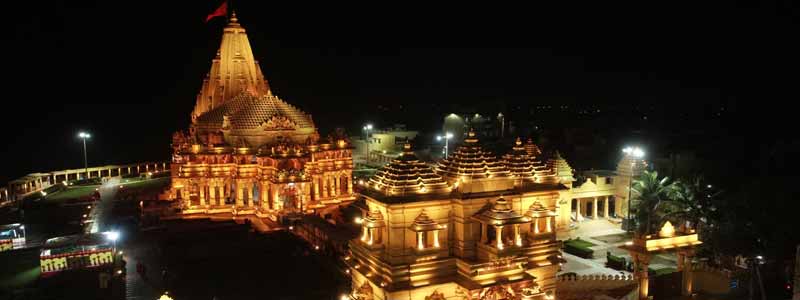
Best Time to Visit Somnath:
Somnath Temple in Gujarat is a place which offers a pleasant climate throughout the year. This is why; people from different parts of the world keep visiting here all through the year. But to make it easier for all, we have listed below the type of weather that prevails during different seasons of the year.
a. Summers (March to June) : The maximum temperature in Somnath during summers is somewhere around 42 °C and minimum temperature level is around 24 °C. The temperature remains high during April and May. So, those who dislike high temperature should avoid visiting the place in summers.
b. Monsoons (July to September) : Monsoons in Somnath come with strong winds and rainfall. The climate during monsoons keeps swinging between humid and cool. Those who wish to enjoy a cool and soothing climate can visit during this period.
c. Winters (November to February) : The temperature during winter season ranges from 10 °C to 34 °C. It is considered the best period of for pilgrimage visits and sightseeing. It is the best time for those who enjoy a cooler climate.
So, the ideal time to visit Somnath is from October to March. This period offers a pleasant and cool atmosphere to the travelers, Somnath Temple in Gujarat.
How to Reach Somnath :
By Air : Keshod is the nearest airport at a distance of 55 km from Somnath. This airport is well-connected to Mumbai. Further, Mumbai is connected to major cities of the world. After reaching Keshod airport, travelers can take any local means like bus or taxi to reach Somnath.
By Train : The nearest rail head is Veraval which is 7 km from Somnath. There are special trains running from Ahmedabad to Veraval. Ahmedabad is further connected to major cities of the country. After reaching Veraval, travelers can take bus, auto or taxi, Somnath Temple in Gujarat.
By Road : All the important places of Gujarat are connected to Somnath. While Ahmedabad is 400 km, Bhavnagar is 266 and Porbandar is 122 km away from Somnath. All other major cities of the country are also connected to Somnath via road.
So, it’s time you pack up your bags and visit this pilgrimage site to seek blessings. When you visit Somnath, don’t miss paying a visit to some more attractions in Somnath which include Parasuram Temple, Panch Pandav Gufa, Balukha Tirtha, Suraj Mandir, Junagadh Gate, Triveni Ghat and many more.

